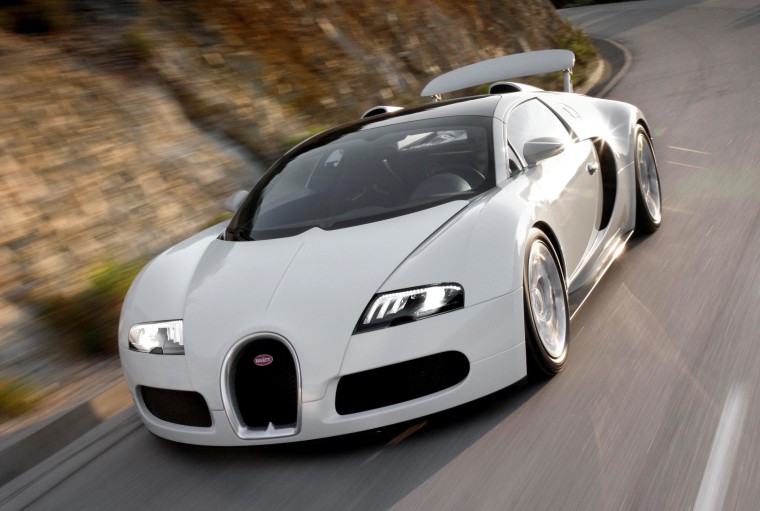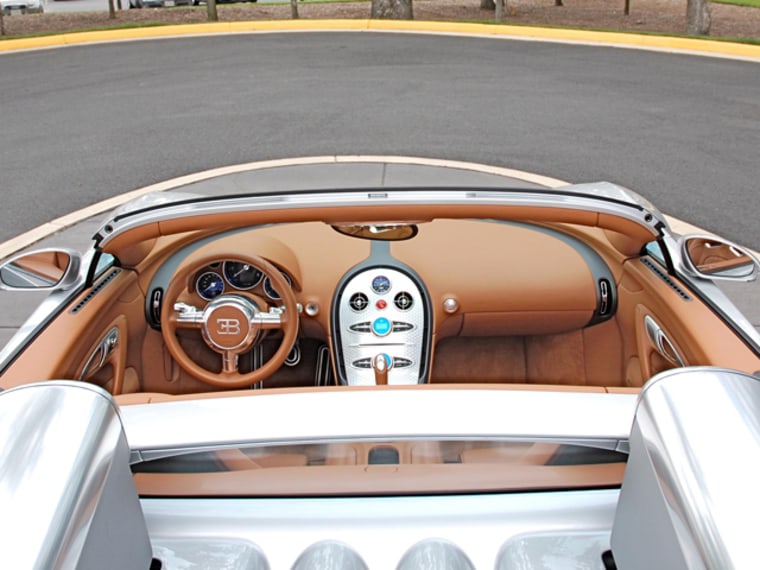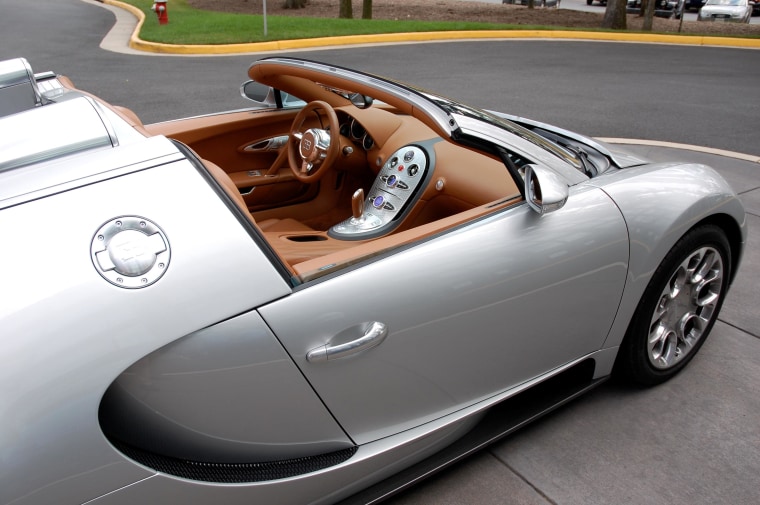“What if?” It's the powerful question that has fired the imagination of innovators throughout history. And would-be innovators too, sitting bored in school, imagining “what if?” when sketching their dream cars.
This was the kind of unrestrained thinking, backed by an unrestrained budget, that produced the original Bugatti Veyron, a shocking 1,000 horsepower, all-wheel-drive cruise missile of a car. But then someone said, “What if … we cut the roof off and made it a convertible?” and recently, the $2 million Veyron 16.4 Grand Sport was born.
Naturally, a $2 million car comes packed with enough gadgets for James Bond, some aimed at helping corral those thousand horses and others technology that performs the magicians’ trick of doing their work without attracting notice.
We should immediately address the capabilities for which the Veyron is notorious: Yes, its 8-liter, W-16 engine features four turbochargers which really do pump up its prodigious power production to a mythical 1,000 horsepower. There is even a “horsepower” gauge on the far left side of the dashboard that shows how much of the Marianas Trench-deep power reserves the driver is tapping at any time.
Also, yes, the Veyron really does go 250 miles per hour — 253, actually — but only after some suitably dramatic double-secret agent, nuclear launch-code-type preparations.
Hidden capabilities
As any suitably imaginative dreamer knows, such cars are subtle in their function, with hidden capabilities and gadgets that whir into action only when needed, and the Veyron doesn’t disappoint.
Something as uncouth as a big, garish flat-panel video display disfiguring the leather-swaddled dash might be acceptable in lesser cars that only cost six figures. But in the seven-figure price range, navigation and back-up camera displays must be less, um, obvious. In the case of the Veyron, the rear-view mirror houses the display screen in its left-most quadrant when those functions are called upon.

The driver enters the navigation destination using the touch-screen interface on an included Hewlett-Packard iPaq HX2000 PDA running Bugatti’s own custom software.
The iPaq also serves as the conduit for pairing a phone with Bluetooth to the car, and runs a utility called Bugatti View, which gives drivers a summary of the car’s activities. It presents the pressure of all four tires, and reports on how much engine power has been used while driving, the car’s average speed, the lateral and longitudinal acceleration and even tire temperatures.
Asked whether it seems curious that the world’s most expensive car relies on off-the-shelf consumer electronics as its driver interface for the car’s electronic systems, Bugatti representative David Jenkins noted: “Bugatti makes motorcars, not little computers.”
Speed potential
Of course, James Bond and Speed Racer can both do more than navigate with their cars’ gadgets and so it is with the Veyron. Much of this is related to the car’s astounding speed potential.
The first speed-related function is automatic: the windows automatically raise at 100 mph to promote aerodynamic stability. In a car that leaps from a stop to window-raising velocity in a scant five seconds, the launch involves the kind of face-stretching, chest-compressing forces associated with the latest amusement park “Terrifying Snake of Catastrophe” thrill ride than with anything as mundane as an automobile.
Piloting the Veyron up to that point has the sensation of taxiing a World War II war bird to the flight line. The massive engine lopes lazily, but authoritatively. There is never any doubt of the gigantic reservoir of power within, and like aircraft piston engines, the Veyron’s powerplant runs at relatively low speeds, so it rumbles and thunders like an old fighter rather than shrieking like a Formula 1 racer.
Tip into the gas pedal and the engine’s startling cacophony blasts out of the dual intake scoops that aim forward at the occupants’ heads.
Now the fighter plane sounds angry, like it has engaged in a dogfight, and its fury is unexpected because of the car’s placidity up to that point. Jump off the gas pedal and Dr. Jekyll returns.
Separate 'Top Speed' key
But stay on it and the car presses relentlessly forward. When it passes 137 mph, the Veyron automatically switches to attack mode. OK, they don’t actually call it that. Instead it is called “Handling” mode, and this entails lowering the car from 4.92-inch ground clearance to a more stable 3.15 inches in the front, and 3.74 inches in the rear.
It also raises the retracted rear spoiler to a maximum angle of 27 degrees to force the rear of the car onto the tarmac — er, road — with extra authority. The car also opens flaps in the front air diffusers for increased front adhesion.
For super-high-speed operation (beyond 234 mph) on a humongous test track or the Bonneville Salt Flats or some other suitably spacious venue, the Veyron can be set to “Top Speed” mode. This requires the driver to insert a special top speed key into a separate ignition-type lock, though it is an unsubstantiated rumor that a suitcase containing secret launch codes is also involved.
Doing this lowers the Veyron to a shade over 2-1/2 inches off the ground and trims the rear spoiler to a scant 2 degrees of angle for reduced drag, and closes off the front diffuser flaps to maintain the correct balance of front-to-rear grip.
With enough open space, skill and nerve, the Veyron is now ready to break the sound barrier. OK, maybe not, but 253 mph will surely feel supersonic in a ground vehicle.
When the ride ends, a touch of the brake pedal deploys the aircraft-like air brake. It isn’t a thrust reverser like airliners use, but it stands the rear spoiler up to a 55-degree angle, increasing the Veyron’s coefficient of drag from .36 to .68.

More amazing than all of the Veyron’s power and technology is the fact that Bugatti’s engineers have managed to make the world’s fastest production car completely civilized to drive in normal conditions.
There is no uneven idle, no temperature needle menacing the gauge’s red zone, no bone-jarring ride, no frenetic kickback through the steering over pavement irregularities. Thanks to the automatic shifting, dual-clutch transmission, there is no leg-straining clutch pedal to modulate.
Not too gentrified
Just as miraculously, despite an enormous dose of civilizing technology, the Veyron is in no way gentrified. The car is constantly rumbling and burbling with purpose, and even a quick squirt of the gas is rewarded with the sounds of powerful machinery at work.
Although there is no overload of negative feedback through the seat and steering wheel, there is still ample information pouring through about the car’s interaction with the road, ensuring a strong involvement with the activity of driving.
Nothing costs as much as the Veyron, or is as fast, but some other similarly exotic supercars are so refined that they leave the driver feeling like a passenger, uninvolved with the plot.
Bugatti’s ability to tame a thousand horses without neutering them is an impressive achievement. That’s what 2 million bucks gets you.
